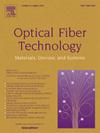基于掺锗纤芯和内包层光纤的用于高温传感的迈克尔逊干涉仪
IF 2.6
3区 计算机科学
Q2 ENGINEERING, ELECTRICAL & ELECTRONIC
引用次数: 0
摘要
我们提出并演示了一种基于光纤迈克尔逊干涉仪的温度传感器。迈克尔逊干涉仪包含一根特殊的光纤,掺锗纤芯和纯二氧化硅内包层,因此干涉频谱是由纤芯的模式和内包层的一个模式干涉形成的。内包层的存在减少了相互作用的包层模式数量。将传感器在 600 °C 的温度下退火 300 分钟后,没有观察到干涉频谱的热滞后现象。该传感器在 20-250 ℃ 范围内的温度灵敏度为 48 pm/℃,在 250-600 ℃ 范围内的温度灵敏度为 78 pm/℃。但是,当传感器暴露在 700 ℃ 及以上的恒温环境中数小时后,就会观察到干涉光谱的波长偏移。这种即使在固定温度下也会发生的波长偏移取决于退火的温度。这可以用玻璃在高温下发生的一系列过程来解释:玻璃的假定温度变化、氧化锗从玻璃芯扩散、玻璃芯和包层的热膨胀系数差异导致的机械应力形成,以及这些机械应力在高温下的松弛。本文章由计算机程序翻译,如有差异,请以英文原文为准。
Michelson interferometer based on a fiber with a germanium-doped core and inner cladding for high-temperature sensing
We proposed and demonstrated a temperature sensor based on a fiber Michelson interferometer. The Michelson Interferometer contains a special fiber with a germanium-doped core and pure silica inner cladding, so the interference spectrum is formed as a result of interference of the mode of the core and one of the modes of the inner cladding. The existence of inner cladding reduces the number of interacting cladding modes. When annealing the sensor for 300 min at a temperature of 600 °C, no thermal hysteresis of the interference spectrum was observed. The temperature sensitivities of the proposed sensor are 48 pm/°C in the range of 20–250 °C and 78 pm/°C in the range of 250–600 °C. But when the sensor was exposed to a constant temperature of 700 °C and above for a few hours, a shift in the wavelength of the dip of the interference spectrum is observed. This wavelength shift, which occurs even at a fixed temperature, depends on the temperature of annealing. It can be explained by a number of processes occurring in glass at high temperatures: the changing fictive temperature of the glass, diffusion of germanium oxide from the core, and formation of mechanical stresses resulting from the difference in thermal expansion coefficients of the core and cladding, and relaxation of these mechanical stresses at an elevated temperature.
求助全文
通过发布文献求助,成功后即可免费获取论文全文。
去求助
来源期刊

Optical Fiber Technology
工程技术-电信学
CiteScore
4.80
自引率
11.10%
发文量
327
审稿时长
63 days
期刊介绍:
Innovations in optical fiber technology are revolutionizing world communications. Newly developed fiber amplifiers allow for direct transmission of high-speed signals over transcontinental distances without the need for electronic regeneration. Optical fibers find new applications in data processing. The impact of fiber materials, devices, and systems on communications in the coming decades will create an abundance of primary literature and the need for up-to-date reviews.
Optical Fiber Technology: Materials, Devices, and Systems is a new cutting-edge journal designed to fill a need in this rapidly evolving field for speedy publication of regular length papers. Both theoretical and experimental papers on fiber materials, devices, and system performance evaluation and measurements are eligible, with emphasis on practical applications.
 求助内容:
求助内容: 应助结果提醒方式:
应助结果提醒方式:


